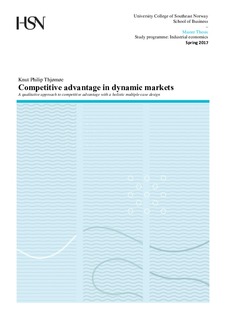| dc.description.abstract | The general interest in competitive advantage amongst academics has resulted in an extensive development of theoretical frameworks. Different theories fits in different markets based on the market characteristics. Increased globalisation has resulted in dynamic business environments and companies find themselves competing in an innovation-based economy. The resource-based view is one of the most prominent theories of competitive advantage, but is more applicable in static markets. The dynamic capabilities theory is an extension of the resource-based view of the firm and emphasises markets with a high level of dynamism.
The resource-based view assumes that the resources are divided heterogeneously amongst firms in an industry and that these resources are imperfectly mobile. The scarcity of these resources allows firms to benefit from first mover advantages. Resources that are valuable, rare, non-imitable and non-substitutional has the potential to create sustained competitive advantage. In dynamic markets, the theory suggests that the source of competitive advantage lies in the firm’s ability to continuously create, change and modify these resources in order to benefit from opportunities presented in the market. Sustained competitive advantage is obtained by continuous repositioning to gain a series of temporary advantages. The purpose of this study is to investigate which factors are important in achieving and sustaining competitive advantage in dynamic markets. Therefore, the research question for this master thesis is as follows.
“What are the sources of competitive advantage in a business environment characterized by high dynamism, and how is the competitive advantage sustained in such markets?”
This study uses a qualitative research approach with a holistic multiple-case design. Four companies are participating whereby two are experiencing a competitive advantage and two are experiencing a competitive disadvantage. The data collection was done through structured interviews with two informants from each case. Each case was first analysed separately before I conducted a comparative analysis in order to search for patterns amongst the cases.
The findings of this study support the existing argument that the resource-based view is less applicable in dynamic markets. However, this study also highlights a clear link between the resource based view and the dynamic capabilities theory. Furthermore, this study suggests that each company possesses dynamic capabilities but the differences lies in the rapidness of which they are deployed. The companies with a competitive advantage has a more continuous deployment of dynamic capabilities than the companies with a competitive disadvantage. The findings also suggests that dynamic capabilities are necessary to simply survive in a dynamic market. Practitioners should strive to obtain a company culture that manages internal changes well in order to adjust to the market dynamism. This study contributes theoretically by emphasising that time is an important factor when describing the phenomenon competitive advantage in dynamic markets. A competitive advantage cycle was identified which supports the argument of the dynamic capabilities theory that companies can obtain sustained competitive advantage through a series of temporary advantages. | nb_NO |
